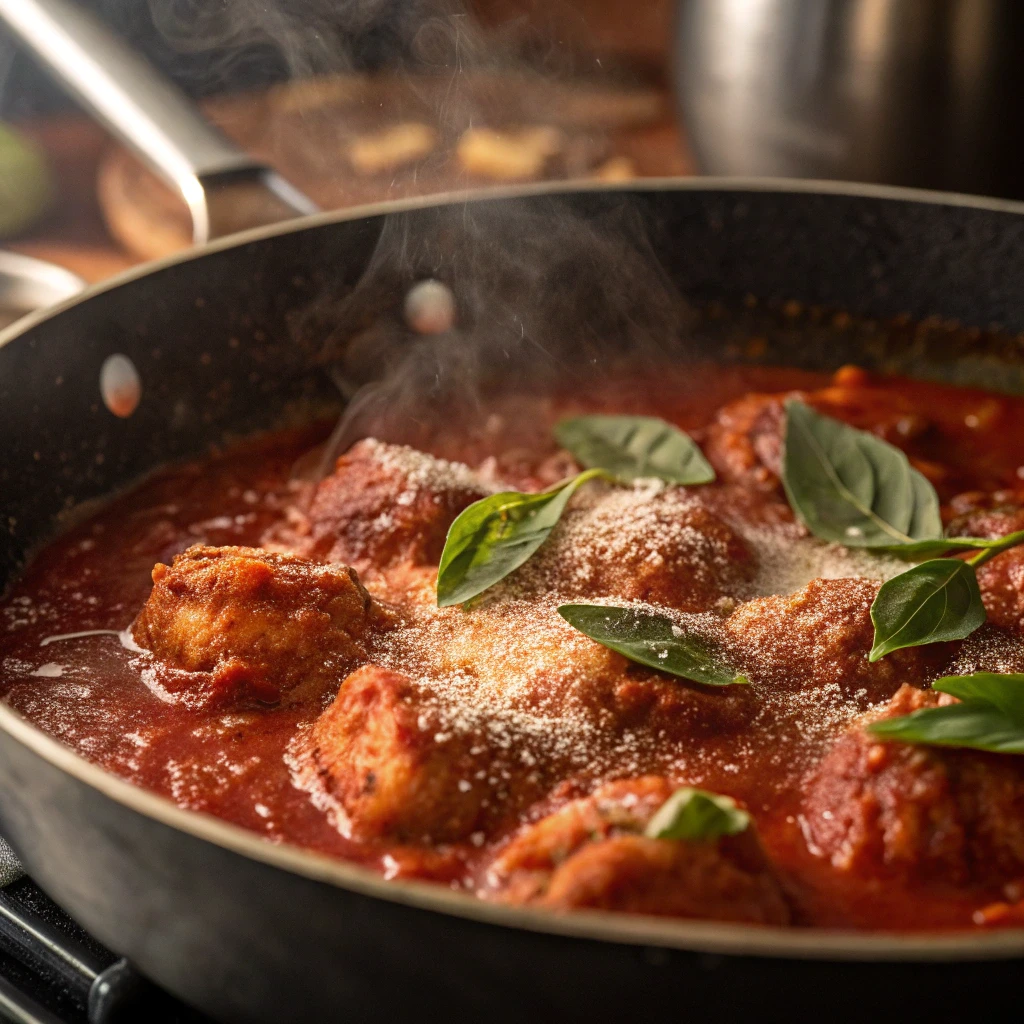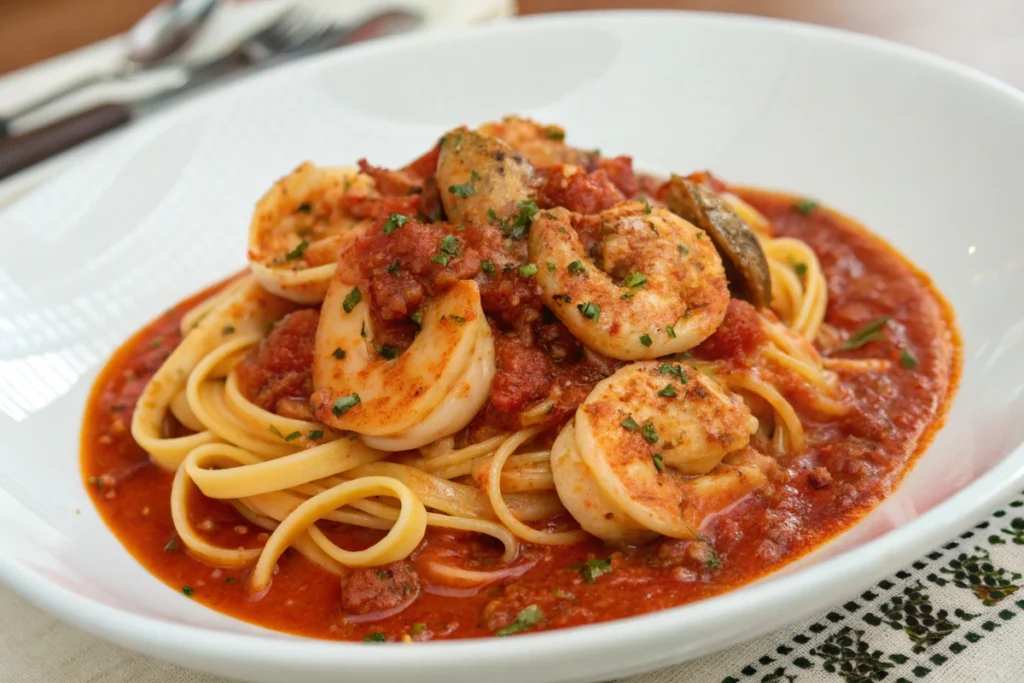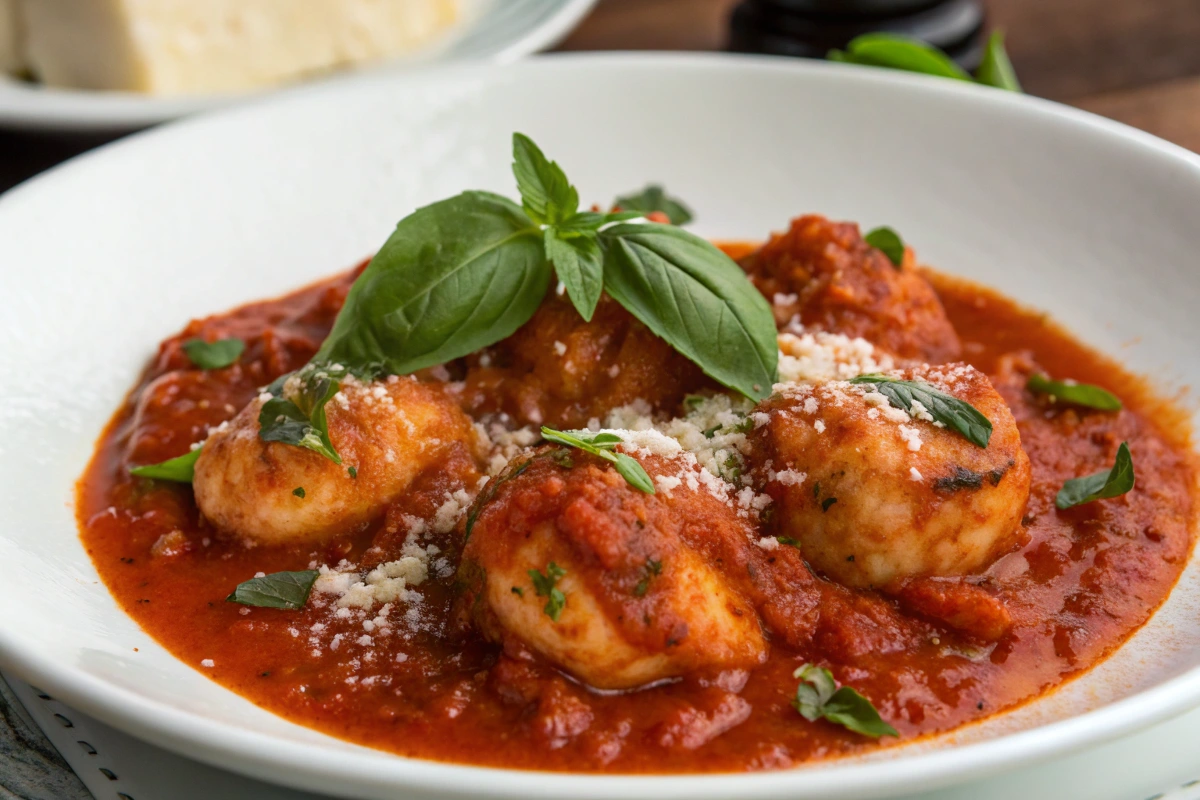Scungilli is a delicacy that often graces the tables of Italian seafood lovers, especially during festive meals like the Feast of the Seven Fishes. This dish, made from the meat of conch shells, has been a beloved part of Mediterranean cuisine for generations. In this article, we’ll explore the fascinating world of scungilli, from its origin and history to popular recipes and helpful cooking tips. Whether you’re a seasoned chef or a beginner in the kitchen, you’ll find plenty of delicious ideas to incorporate this unique ingredient into your meals.
What is Scungilli?
Scungilli is a term used to describe the meat from a specific type of sea snail, known as the conch. The word scungilli comes from the Italian term for “conch,” and in many Italian-American households, it’s the centerpiece of various traditional seafood dishes. Let’s dive into its background and how it became such a staple in Mediterranean cuisine.
The History and Origin of Scungilli
Scungilli has deep roots in Italian coastal cuisine. Historically, it has been consumed in southern Italy, particularly in regions like Sicily and Naples. The conch, which is a type of sea snail, has been a valuable food source in Mediterranean cultures for centuries. Over time, the tradition of using scungilli in pasta dishes, salads, and even in marinara sauce became widespread, especially during holiday celebrations.
As Italian immigrants moved to the United States, they brought this delightful seafood with them. Today, scungilli is found in many Italian-American kitchens, where it’s often prepared in various forms—marinated, in pasta, or in hearty stews. But it’s during the Feast of the Seven Fishes that scungilli truly shines, making it an essential dish for many families.
Scungilli vs. Conch: What’s the Difference?
While scungilli and conch are often used interchangeably, there’s a subtle difference. The term scungilli specifically refers to a type of sea snail found in Mediterranean waters, whereas conch is a broader term that can apply to various species of sea snails from different parts of the world. Despite this, the meat of both is quite similar in taste and texture. Both are prized for their mild, chewy texture, making them an ideal addition to many seafood recipes.
Nutritional Benefits of Scungilli
Health Benefits of Scungilli
Scungilli, a type of sea snail, is not only flavorful but also packed with nutrients that can support a healthy diet. One of the primary benefits of scungilli is its high protein content. It’s an excellent source of lean protein, which is essential for muscle growth and repair. If you’re looking for a protein-packed meal without excess fat, a scungilli recipe can be a perfect choice. A 3-ounce serving provides around 20 grams of protein, making it a great addition to any meal.
In addition to being high in protein, scungilli is rich in omega-3 fatty acids. These healthy fats are known to help reduce inflammation and support heart health by lowering bad cholesterol. Omega-3s are essential for overall well-being, and incorporating scungilli into your diet is an easy way to boost your intake of these beneficial fats.
Furthermore, scungilli provides several key vitamins and minerals. It’s an excellent source of vitamin B12, which is vital for energy production and healthy nerve function. It also contains iron, which helps in oxygen transportation, zinc for immune function, and magnesium for muscle and nerve health.
Adding Scungilli to Your Diet
Incorporating scungilli into your meals is simple and can enhance the nutritional value of your dishes. Since scungilli is low in calories and carbohydrates, it’s an ideal choice for those following a Mediterranean, low-carb, or paleo diet. You can enjoy it in a variety of ways, whether it’s part of a fresh scungilli recipe served as a salad or added to pasta for a hearty, healthy meal.
For a well-rounded dish, try pairing scungilli with vegetables, whole grains, and healthy fats like olive oil. This combination provides a balanced mix of protein, fiber, and healthy fats that make for a satisfying meal.
By adding scungilli to your diet, you’re not only enjoying its delicious taste but also reaping the nutritional benefits that come with it.
Popular Ways to Cook Scungilli
Scungilli is an incredibly versatile ingredient, and there are so many ways to enjoy it. Whether you’re craving something light and fresh or something spicy and hearty, there’s a scungilli recipe for every occasion. Let’s explore some of the most popular ways to cook scungilli that are guaranteed to wow your taste buds.
Scungilli in Marinara Sauce
One of the most classic ways to prepare scungilli is in marinara sauce. This method brings out the natural flavor of the conch meat while infusing it with the rich, tangy goodness of tomatoes, garlic, and herbs. The key to a perfect scungilli recipe is to cook the scungilli just enough so that it absorbs the sauce without becoming tough. Serve this dish with pasta, like spaghetti or linguine, for a comforting, satisfying meal. For an extra kick, add some red pepper flakes to the sauce—this helps balance the mildness of the scungilli with a touch of heat.

Scungilli Salad: The Feast of the Seven Fishes Tradition
Another delicious way to enjoy scungilli is in a scungilli salad, especially popular during the Feast of the Seven Fishes. This dish combines tender pieces of scungilli with crunchy vegetables like celery, bell peppers, and onions. Toss everything in a simple olive oil and lemon dressing, and you’ve got a refreshing, flavorful dish perfect for any occasion. The salad can also be spiced up with pickled peppers or olives, which add an extra layer of complexity to the dish. It’s light, yet full of flavor—making it an excellent appetizer or side dish for a seafood feast.
The Best Scungilli Recipes
Now that we’ve covered the basics, it’s time to dive into some of the best scungilli recipes around. These dishes showcase the versatility of this seafood and provide fantastic ways to bring it to the table. Whether you’re preparing a quick meal or something a bit more elaborate, these recipes are sure to impress.
Classic Scungilli Marinara with Linguine
One of the most beloved ways to prepare scungilli is with marinara sauce. This scungilli recipe is a crowd-pleaser that combines the chewy texture of scungilli with the rich, savory flavor of homemade marinara. To make it, you’ll sauté garlic in olive oil until golden, then add crushed tomatoes, herbs, and scungilli. Simmer it all together for a few minutes to allow the flavors to meld. Serve this over linguine for a meal that’s both satisfying and comforting. Add a sprinkle of parmesan cheese and fresh basil to complete the dish.
Scungilli Pasta in Spicy Fra Diavolo Sauce
For those who like a little heat, a scungilli recipe made with fra diavolo sauce is a must-try. Fra diavolo, which translates to “devil’s sauce,” is a spicy blend of tomatoes, garlic, red pepper flakes, and herbs. The heat from the chili peppers pairs perfectly with the delicate flavor of scungilli. Cook the scungilli in the sauce until it’s tender, then toss it with your favorite pasta. The result is a dish with bold flavors that’s sure to satisfy anyone who enjoys a little spice in their meal.
Orecchiette with Scungilli and Neonata Sauce
This scungilli recipe offers a unique twist, perfect for those looking for something a little different. Pair orecchiette, a small, ear-shaped pasta, with scungilli and neonata sauce, made from salted anchovies, garlic, and olive oil. The briny, umami flavor of the neonata sauce complements the mild, chewy texture of the scungilli beautifully. You can easily prepare this dish, and it feels incredibly sophisticated. Sprinkle fresh parsley on top to bring everything together.
Serving Suggestions for Scungilli Recipe
How to Serve Scungilli for Maximum Flavor
Scungilli, with its firm texture and delicate flavor, makes for an outstanding main course or appetizer. You can serve it as a light dish, paired with crisp greens or a zesty tomato salad. For a more indulgent option, consider tossing it with pasta for a hearty seafood pasta dish. To balance its rich flavor, a fresh, lemony garnish or a drizzle of extra virgin olive oil works wonders.
Additionally, the versatility of a scungilli recipe allows it to be enjoyed hot or cold. If you’re serving it cold, it’s perfect as part of a seafood platter alongside shrimp and oysters. On the other hand, if you prefer a warm dish, you can sauté the scungilli in garlic and olive oil, or even prepare it in a classic marinara sauce. The key is to allow the natural taste of the scungilli to shine through, without overpowering it with too many strong flavors.
Pairing Wine with Scungilli
Pairing the right wine with your scungilli recipe can elevate the overall dining experience. A crisp, refreshing white wine such as Sauvignon Blanc or Pinot Grigio complements the seafood’s delicate taste. If you’re making a spicier version of your scungilli recipe, a slightly off-dry Riesling can balance the heat without overwhelming the palate. For a richer dish, like scungilli in a tomato-based sauce, a light red wine such as Pinot Noir works wonderfully, bringing out the umami of the dish.
If you love seafood, you might also enjoy this delicious Seared Ahi Tuna Recipe or try a comforting bowl of Grandmother’s Omaha Clam Chowder for another flavorful and hearty dish
Variations of Scungilli Recipe
Scungilli Salad with Lemon and Olive Oil
For a light, refreshing take on the traditional scungilli recipe, try preparing a scungilli salad. The tender texture of the scungilli pairs beautifully with fresh vegetables like tomatoes, cucumbers, and red onions. Toss the ingredients together with a generous squeeze of lemon juice, a drizzle of extra virgin olive oil, and a pinch of sea salt. This simple yet flavorful dish is perfect for hot summer days when you want something refreshing and light.
Scungilli in Spicy Tomato Sauce
For those who enjoy a bit of heat, a scungilli recipe in a spicy tomato sauce is an excellent choice. You can sauté garlic and red pepper flakes in olive oil, then add crushed tomatoes, fresh basil, and the scungilli. Let it simmer until the flavors meld together, and serve it over pasta or as a standalone dish with crusty bread. This variation adds a touch of warmth and spice, perfect for cooler evenings or when you’re craving something more robust.

How to Make Scungilli Recipe: Step-by-Step Guide
Preparing the Scungilli for Cooking
Before diving into your scungilli recipe, it’s essential to prepare the scungilli properly. Start by thoroughly rinsing the shells under cold water to remove any grit or debris. Depending on your recipe, you may need to remove the tough outer membrane of the scungilli to reveal the tender, firm meat inside. Some scungilli recipes call for you to cook the shells briefly in boiling water, then slice the meat into bite-sized pieces. Whether you’re making a warm seafood dish or a chilled salad, this preparation ensures that your scungilli is clean, tender, and ready to shine in your dish.
Cooking the Scungilli: Quick and Easy Methods
Once prepared, cooking scungilli is a breeze. If you’re making a simple sauté, heat a couple of tablespoons of olive oil in a pan over medium heat. Add the scungilli and cook for 2-3 minutes until they turn slightly golden. For a more intricate scungilli recipe, you may simmer the scungilli in a flavorful broth, such as a tomato or white wine base. Always be mindful not to overcook the scungilli; they should remain tender and firm, not rubbery. The beauty of scungilli is in its quick cooking time, making it perfect for weeknight dinners or special occasions.
FAQs About Scungilli Recipe
What can I do with a can of scungilli?
With a can of scungilli, you can create a delicious seafood pasta by simmering it in marinara sauce. Alternatively, toss it in a fresh salad for a light and refreshing dish. Moreover, you can sauté it with garlic and olive oil for a simple yet flavorful appetizer. Finally, adding it to a seafood stew brings depth and richness to the broth.
Is canned scungilli already cooked?
Yes, canned scungilli is typically already cooked, making it convenient for quick meals. However, it’s important to rinse it well to remove excess brine before using it. Additionally, you can heat it up in sauces or soups without worrying about overcooking. Finally, it’s ready to be enjoyed in salads, pastas, or any dish that calls for tender seafood.
Are calamari and scungilli the same?
No, calamari and scungilli are not the same. Calamari refers to squid, known for its tender, slightly chewy texture. In contrast, scungilli is the meat from conch shells, which has a firmer, more dense texture. While both are popular in Mediterranean cuisine, they come from different marine species and offer distinct flavors in dishes.
How do you tenderize scungilli?
To tenderize scungilli, start by gently simmering it in a flavorful broth or sauce for a short period, as overcooking can make it tough. You can also briefly blanch scungilli in boiling water for about 2-3 minutes before adding it to your dish. Additionally, marinating it in a mixture of olive oil, lemon juice, and herbs can help soften the texture. Finally, slow cooking it in a rich sauce or stew allows it to absorb flavors while staying tender.
Enjoying Your Scungilli Recipe
Whether you’re a seafood aficionado or new to Mediterranean cuisine, the scungilli recipe offers a fantastic opportunity to explore new flavors and textures. This tender, flavorful sea snail can be prepared in countless ways, from classic marinara dishes to fresh, zesty salads. Its versatility makes it perfect for any occasion, whether it’s a festive holiday meal or a weeknight dinner.
By following the step-by-step guide, you can easily incorporate scungilli into your meals, adding a unique and delicious twist to your seafood repertoire. With the right preparation and a few simple ingredients, you can enjoy the authentic flavors of this Mediterranean delicacy right at home.
Remember, the beauty of any scungilli recipe is in its simplicity—let the natural flavors of the sea shine through, and you’ll have a dish that will impress every time. So, grab some scungilli, get creative with your recipe, and savor the taste of the Mediterranean in your kitchen!

